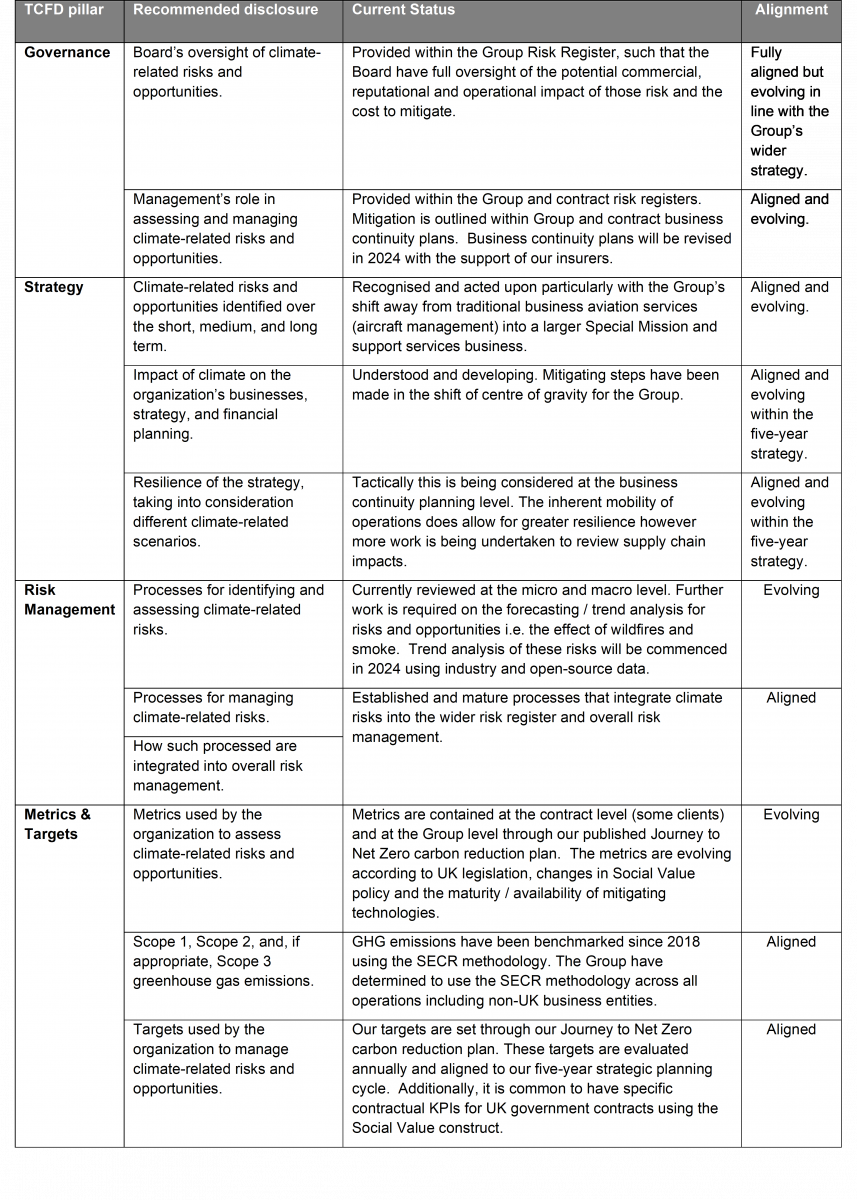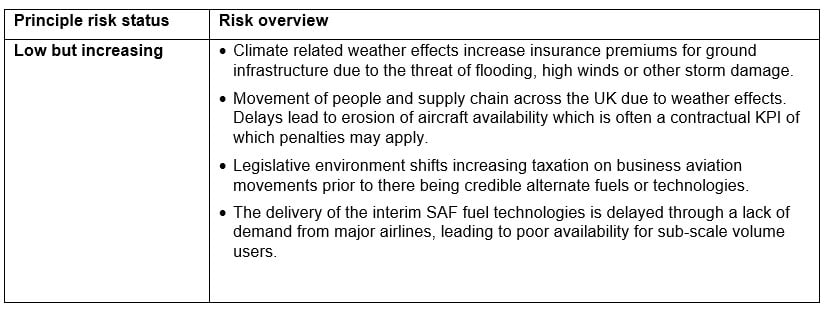The Group’s Task Force on Climate-related Financial Disclosures (TCFD)
Since our first greenhouse gas emissions audit in 2018, we have sought to introduce greater transparency and accountability into the Group. Despite operating in an acknowledged “hard to abate” industry we are making progress and are optimistic of attaining our goals.
Alignment Status
The following table provides a summary of our current alignment with TCFD recommendations.
Governance
Our governance of climate-related matters is delegated, closely following the Group’s established model. Roles and responsibilities are defined as below:
- Board of Directors: Reviews the corporate risk register and approves mitigating strategies and overall risk appetite. This includes those related to sustainability and climate. Due to the lack of available Committee time, the Board has delegated the role of the CSR Committee to EXCO (at the behest of the EXCO members), this was ratified on the 2nd December 2023.
- CEO: Is the sponsor of our sustainability and climate-related strategy. Actions relating to mitigating strategies are delegated to the Chief Compliance Officer and the strategic business unit Managing Directors. The CEO chairs EXCO.
- Chief Compliance Officer. Is the owner of the Group Risk Register, providing the oversight and delegation of responsibility to mitigate risks. Updates the Board in relation to all risks including material sustainability and climate issues and decisions. Reports to the CEO and Board.
- EXCO team. Led by the CEO, the team contains the strategic business unit MDs and Group Function heads. The team has responsibility for implementing strategy, company targets, including climate-related targets, and reporting on progress to the CEO.
- Chief Marketing Officer. Sets the strategic direction for Project Element Six. Leads environmental and social value-related proposals at the EXCO and contract level. Reports to the CEO.
- Head of Safety. Is responsible for ISO14001:2019 compliance of the Group’s environmental management systems which include those relating to sustainability and climate issues. Reports to the CCO.
Strategy
In 2019, the Group set the following aims in its Carbon reduction plan, Journey to 2050. From the start, we acknowledged that while our business has cause to address its own emission profile, substantial work would need to be undertaken to move the needle in scope 3 emissions related to our clients’ use of their aircraft.
This remains the case and unless legislation forces a more immediate change, innovations in fuel technology, fleet replacement cycles and substitute technologies remain central to our ability to realise our Net Zero ambition.
The three pillars of our strategy are as below.
Change our behaviour and lead by example.
- Reduce our own Group’s Scope 1,2 and 3 GHG emissions, mitigating those that remain by using responsible environmental and/or community schemes that work in accordance with our ESG goals.
Influence the behaviour of our clients.
- Reduce, wherever possible, customer demand-initiated Scope 3 GHG emissions through the incorporation of changes in flight operations, ground operations or any other areas that may reduce fuel burn without compromising safety.
- Use environmental and/or community schemes to mitigate customer demand-initiated Scope 3 GHG emissions, should the prevailing technologies of the planning period be unable to provide the reduction in C02e forecast.
- Positively influence and encourage the adoption of new, enabling technologies, that are commercially available/feasible to reduce customer demand-initiated Scope 3 GHG emissions.
- Support new and enabling technologies that seek to reduce GHG emissions across the wider aviation sector.
- Improve audit accuracy and data such that the Group has, in the future, a near real-time view of carbon emissions which is reported through the current quarterly business review cycle.
- Fix, optimise or add policies/processes and changes in procurement practice that seek to lower the Group’s scope one, two and three emissions through change.
- Further, promote the ability to mitigate GHG emissions for all charter flights booked with us.
- Include as standard, the option to mitigate all GHG emissions within all new aircraft management contracts.
- Include as standard, the option to mitigate all GHG emissions within all UK Government contracts and /or use Project Element Six as the delivery mechanism to achieve this.
- Review, aid and partner with low carbon technologies (fuels, engines, systems) that may substitute current technologies to achieve a low carbon future.
- Internal process requires all contracts to be assessed on a quarterly basis. During these quarterly business reviews, risks are reviewed alongside mitigating actions. Depending on severity and trend these may be elevated to the Group Risk Register.
- Safety Review Board sits to assess primarily aviation safety on the ground and in the air. Climate change induced weather events are understood, particularly their effect on mission viability, ground infrastructure, logistics, etc.
- Compliance and Assurance team’s monitoring of legislation, particularly that associated with air operations issued by the Civil Aviation Authority. The team also monitors changes in the approvals provided by aircraft and engine manufacturers with respect to SAF fuels and blend ratios. Both are critical to manage the risks surrounding airworthiness of our clients’ aircraft.
- Impact to the business
- Likelihood of occurrence
- Relative risk weighting.
- Likely mitigating actions to prevent the risk occurring or reduce the observed risk.
- Cost of those actions.
- Aviation operations, particularly those within the special mission strategic business unit.
- Ground infrastructure, due to wind, flooding and snow.
- Logistics and the weather’s effect on the global supply chain.
- Regular reviews of business continuity planning at a contract level
- A review of the Group’s current business continuity plan with the co-operation of the Group’s insurers.
- Total CO2 emissions (tonnes) (scope 1, 2 and 3 including client emissions)
- Total CO2 emissions (tonnes) (scope 1, 2 and 3 excluding client emissions)
- Total energy consumption
- Tonnes of CO2e per employee
- Maintenance of our ISO 14001:2019 accreditation and reduction of annual audit findings
- Adherence to the objectives, actions and requirements of the Social Value Act as required within our UK government contracts.
- Carbon Reduction Plan targets to achieve Net Zero.
Support and enable substitute technologies.
Delivering change. Project Element Six
The Board acknowledges the efforts by the Business Leadership to adapt to a low GHG emission environment in line with our published Carbon Reduction Plan, Journey to 2050. For the Leadership to continue to deliver Project Element Six with the agility required, the CSR Committee has devolved its responsibilities (ratified on 2nd December 2023) to the Executive Committee (EXCO).
The EXCO is formed by the Executive plus the leadership of the SBUs and Group functions. Over the course of 2024 the EXCO will continue, via Project Element Six, to:
Risk management.
Being a 40-year-old business and operating within a safety critical environment, the Group has a mature process for managing risks and opportunities, through which climate-related risks have been adopted. As such, climate-related risks and opportunities are included as part of the formal review of the Group Risk Register, as conducted by the Chief Compliance Officer. Any deviation is then reported at the quarterly Board meetings. Inputs include, but are not limited to, the following:
Climate risk assessment
Our evaluation of strategic risks is based on a rolling five-year timeline corresponding to the strategic planning cycle of the business. Our risk climate risk forecast can be summarised in the following way:
Climate risk as a subset of risk management
Our policy is to consider climate-related risks in the same way as any other risk type. This allows all risks to be evidenced and evaluated using the following evaluation process.
Impact to the business having taken the mitigating action.
Climate-related risks are not associated as an area per se (the primary areas being Commercial, Financial, Legal & Contractual, Technical, Operational and Safety) but are treated as identifiable risks within these areas. For example, in Operational, the risk would be a facility suffering localised flooding.
Resilience management
Climate change induced weather events will have a primary effect on business continuity planning (BCP). This has implications for:
The Group recognises these emerging risks and is improving its resilience management through:
Metrics and targets
Our climate-related metrics are summarised below and published each year in our Streamlined Energy and Carbon Report (SECR) as well as our Energy Savings Opportunity Scheme (ESOS) and Carbon Reduction Plan Journey to 2050.
Additionally,


